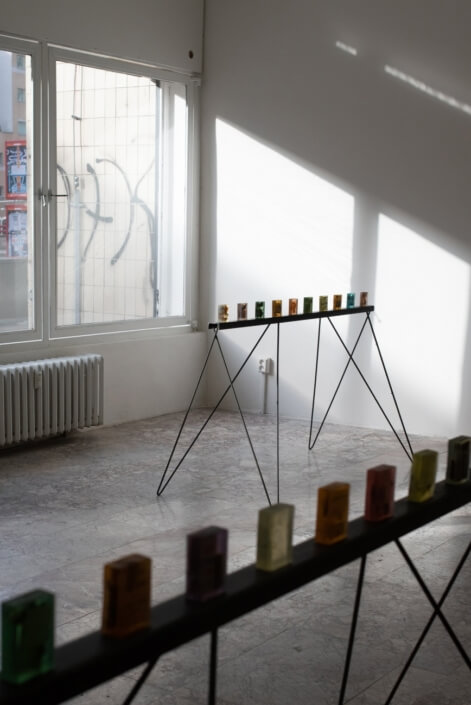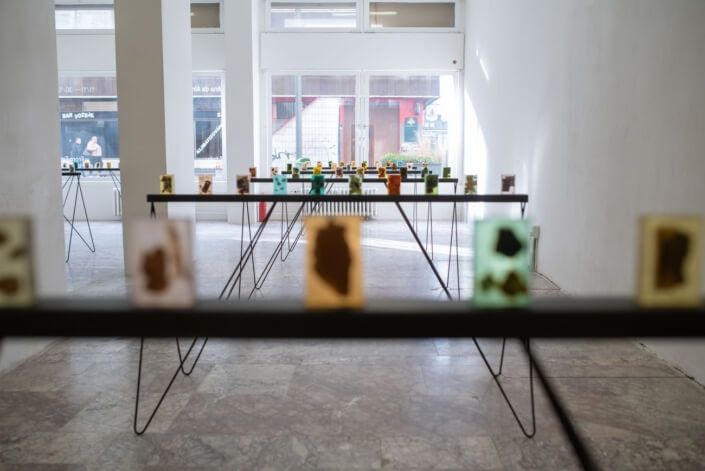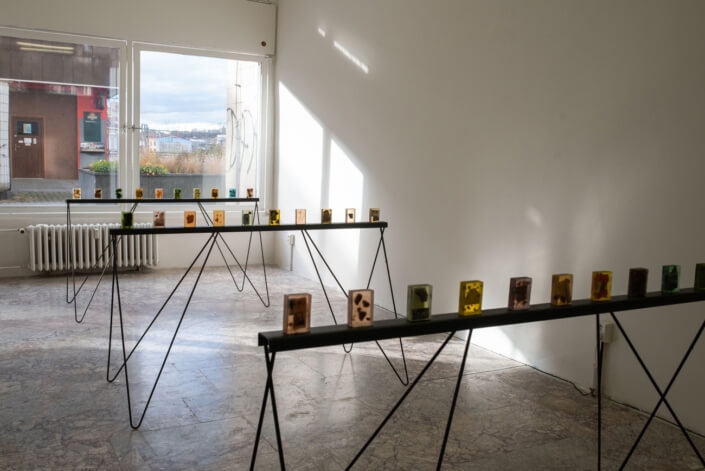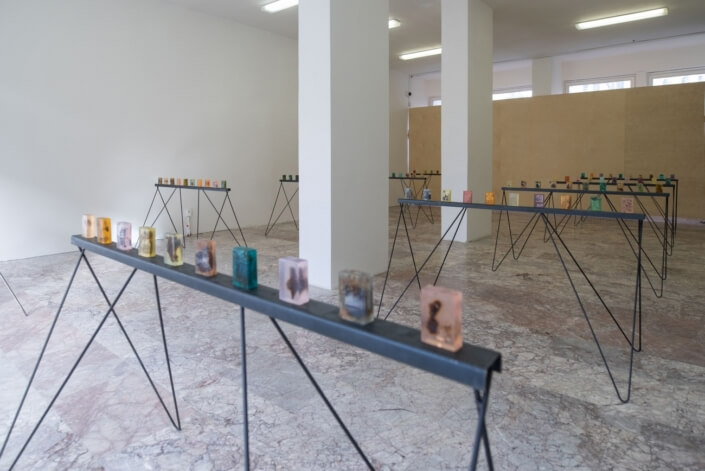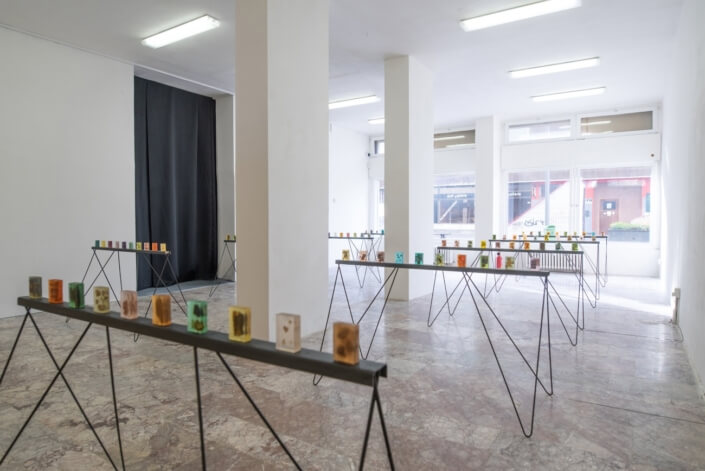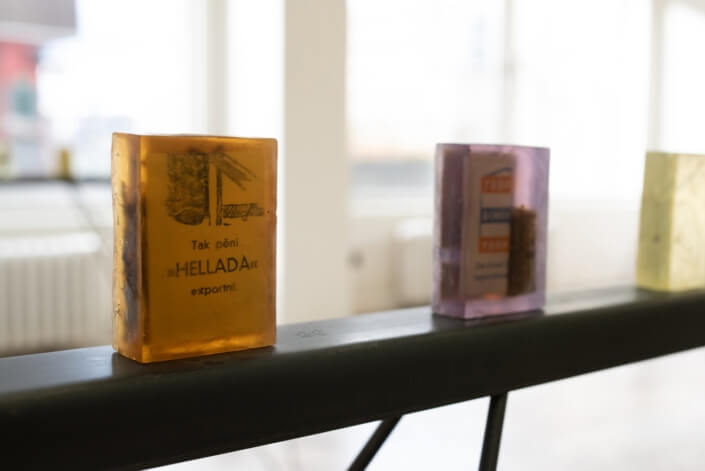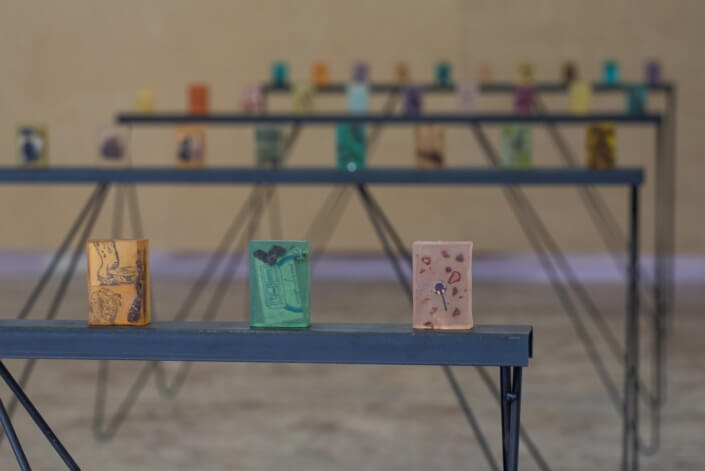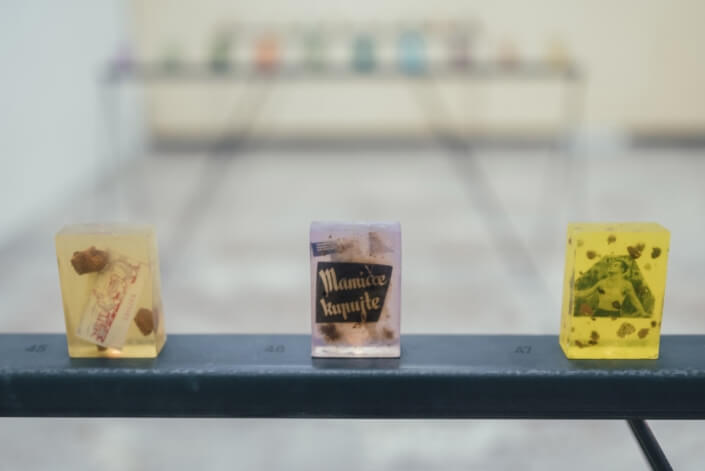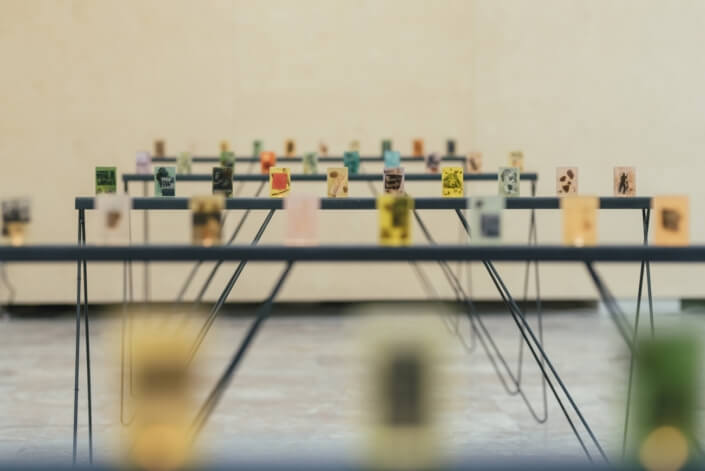From Fat and City
In the exhibition From Fat and the City, Ana de Almeida presents a new work based on her long-standing artistic interest and the research she undertook in Ústí nad Labem during her summer residency. It is a series of 100 handmade soaps, in which archival material associated with the former Schicht factory and the later North Bohemian Fat Factory (Setuza) is preserved. Ana is one of the artists who relate to the artistic strategy of the archival impulse as defined by Hal Foster in 2004. This is meant by working with an artwork using archival material as a disclosure of historical information. The reinterpretation and reinterpretation of ‚big history‘ is also an important aspect. Ana de Almeida, an artist a generation younger and with extensive theoretical knowledge, extends this thinking with new perspectives. The most striking element of her artistic approach is the very destruction of archival material–by cutting, deforming, and fragmenting it. At the same time, however, the archival materials are preserved in a durable material that alters their physical and chemical properties – blocks of glycerine, dye, and aromas – that is, soaps. Ana de Almeida also incorporates into her theorizing a consideration of the archive as a tool of power. For example, by archiving parts of ordinary rubble from a demolished building on the site of the industrial plants, elevating them to important artefacts comparable to fragments of ancient temples or other archaeological finds. This is related to the historical and social change that our Central European society is currently experiencing–the post-industrial transition, in which we are witnessing a fundamental change concerning production, work, consumerism, and other aspects.
For over a hundred years, the factory in Střekov has been influencing the structure of the city and the quality of life of its inhabitants, with both positive and negative effects. At a time of industrial development and with a fundamental change in working conditions, the founder-industrialist Johann Schicht and his descendants built civic amenities in the town–a clinic, a spa, a nursery, a library, and residential buildings for their workers. After the nationalisation of the company, production continued and employed many of the newly settled population. The national enterprise Setuza also associated its employees and allowed them to carry out „superstructure“, especially in the events of the Revolutionary Trade Union Movement (ROH), under which the celebration of International Women’s Day, St. Nicholas‘ Day or children’s camps were organized.
However, the ROH also provided and approved the operation of the amateur theatre group Severotuk, later the successful Malé divadlo. After the privatisation of the company in the 1990s, the operation gradually disappeared, yet until recently it brought an ecological burden to the town, manifested mainly by the deteriorated air quality. However, the industrial production of fruit juices, soaps, toothpaste, and edible fats goes far beyond the city limits. Cooking oil, one of the main ingredients in hygiene products was imported to Ústí nad Labem mainly via Holland from colonised countries. The cultivation of the basic raw material has resulted in economic, ecological, and, above all, social disasters of global significance. Against the backdrop of political and technological change and disappearing production, we are therefore currently returning to thinking about ecological sustainability, the domestic economy, and the overall impact of industrial production on the shape of society. The artist Ana de Almeida has taken these circumstances into account by selecting archival material to incorporate into the artwork. A fundamental inversion can be found in the work – inside the factory in Střekov, soaps (the main production item) were produced. Ana de Almeida, however, presents the factory in the artifacts with all its social, architectural, and historical aspects inside the soaps. The main active elements that are incorporated in the soaps are visual materials – photographs from annual reports, stills from film archives, original advertisements, and other printed materials related to the marketing of the products – and material artefacts – the actual industrial products, copies of Schicht’s cookbook, original souvenirs, the original fat intended for production and the aforementioned rubble from the demolished building.
However, the work exhibited at the Ústí nad Labem House of Arts could be viewed through the prism of other theoretical and artistic approaches – gender issues, environmental and postcolonial tendencies, and other aspects that can be subsumed under critical theories are encoded in it.
Ana de Almeida (1987, Portugal)
The artist with Czech and Portuguese nationality lives and works in Vienna. Her artistic research critically examines the broader historical and macroeconomic contexts that shape European space. She began to process the political and social developments in Czechoslovakia and the similarities or differences with the visual as well as political culture in Portugal based on the photographic archive of her father, who stayed in Prague as a student between 1978 and 1987 as part of a socialist exchange. The image material stored in a shoebox was the building block for Ana’s research project, in which she explores other specific symbols and signs that are mainly associated with the revolutionary period in Portugal (the so-called Carnation Revolution) and the Velvet Revolution in Czechoslovakia. She has used her findings so far in the exhibition Carnations and Velvet – The Art of Revolution in Portugal and Czechoslovakia, organized in 2019 at the Prague City Gallery. Here, for example, she appropriated significant symbols of revolutionary movements and transformed them into the form of an object. Her text with a historical overlap was also published in the exhibition catalogue. After completing her MA in Critical Studies, she continues her Ph.D. program at the Academy of Fine Arts in Vienna, where she teaches a theoretical and practical seminar together with the theorist and critic Diedrich Diederichsen. Ana de Almeida was a 2017-2019 Junior Fellow at the IFK – International Research Centre for Cultural Studies in Vienna. In 2021 she received a state scholarship from the Austrian Ministry of Culture for artists focusing on multimedia production.
The exhibition project was made possible with the financial support of Bundesministerium Kunst, Kultur, öffentlicher Dienst und Sport.
Photo: Filip Trubač
From Fat and City
Ana de Almeida
House of Art Ústí nad Labem
11. 11. – 30. 12. 2021
Curator: Barbora Hájková

